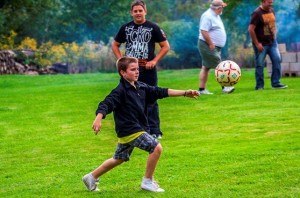
Childhood obesity has been prevalent throughout the years as eating habits shift. Despite efforts targeting the problem, experts argue that though most initiatives offer ways to curb obesity and overweight, it doesn’t prevent it sustainably or address it entirely. The National Health Center for Health Statistics revealed that the number of children affected by obesity in the United States aged 6-11 years increased from 7 percent in 1980 to nearly 18 percent in 2012. There are several discussions on how to fight childhood obesity such as giving proper diet and nutrition, engaging in physical activities, and the like. But what is the best way to fight obesity?
First of all, how do you diagnose obesity? It’s not always easy to tell if a child is affected by obesity as children grow at different rates at different times. Checking through his/her body mass index (BMI) doesn’t entirely result to a perfect measure as some BMI can be misleading and can be difficult to interpret especially during puberty where a children experience periods of rapid growth.
The best thing to do is to get help from your healthcare provider. The doctor can perform further assessments such as determining if excess fat is a problem, evaluations of diet, physical activity, family history, and other appropriate health screenings.
Fat-Shaming Should Not Be Encouraged
Understanding the possible causes on how children become affected by obesity or excess weight is a fundamental step in breaking the cycle. Fat-shaming among kids is probably the most vicious cycle that we should break. At an early age, kids get exposed in fat-shaming through cartoons and movies that are bombarded with fat jokes. PlaygroundEquipment.com talks about how popular fat-shaming movies and cartoons among kids where they are influenced to feel socially awkward with other kids that are not fat. This then contributes to the lessening ratio of kids engaging in physical activity.
As a parent, telling your kid that he is fat and needs to lose weight is not the right way to do it. You should not educate them that being “fat” is a bad thing but rather love your child unconditionally and fight obesity, not people affected by it.

The Culprits
Imbalance between calories in and calories out plays a great factor for weight problems and obesity. Children need more food to support healthy growth and development but most kids take in more calories than they burn each day which then results to weight gain. There are lots of culprits that contribute to weight gain such as easy access to fast food and junk food, big portions of food, and spending less time in physical activity.
Get Their Heartbeat Run Fast
Aside from making healthy food choices, spending ample time in regular physical activity plays a vital role in completing the equation. The American Heart Association recommends that all children aged 2 and older should have at least 60 minutes of moderate-to-vigorous-intensity aerobic activity every day. Physical inactivity can play a major risk in developing coronary artery disease and inactive children are more likely to become inactive adults. Exposing your children to physical activities at an early age can help improve his psychological well-being.

Indoors or Outdoors?
Kids should participate in age-appropriate activities that are enjoyable and offer variety. Children don’t need formal muscle-training programs as these are most suited for adults than to children. Getting active doesn’t always constitute to going outside. A good mixture of both outdoor and indoor activities is important in meeting the Physical Activity Guidelines for Americans.
According to Centers for Disease Control and Prevention, there are 3 types of physical activity that children need each day.
1. Aerobic Activity – Includes either moderate-intensity aerobic activity such as brisk walking, or vigorous-intensity activity such as running and should be done 3 days per week.
2. Muscle Strengthening – Includes muscle strengthening activities such as gymnastics or push-ups, at least 3 days per week as part of your child’s 60 or more minutes.
3. Bone Strengthening – Includes bone strengthening activities such as jumping rope or running, at least 3 days per week as part of your child’s 60 or more minutes.
Be clever in creating new games and activities that kids can enjoy both indoors and outdoors. Don’t let too much snow or sunlight hinder you and your kids and take it as an opportunity to start moving.
More Than Fighting Obesity
Aside from preventing obesity, getting active can give lots of benefits such as being more energetic in class, relieving stress and anxieties, having a healthier heart, improving sleep, and having a stronger immune system.
Fight your kids’ urge to slouch on the couch all day. As a parent, you should set an example to your kids, which means that you shouldn’t also sit in front of the TV or computer all day. Choose activities that are right for your family, create a schedule, and stick to that schedule. Moving more doesn’t mean making your kids train like athletes. Making smart choices such as parking farther than usual and walking to get to the mall or to the grocery will do.
About the Author:
Aby League is a qualitative researcher and a passionate writer. She is an innovator and technology enthusiast. She has been writing about health, psychology, home improvement and technology. To know her more, follow @abyleague on Twitter.

